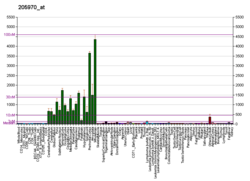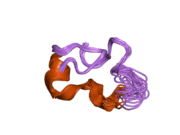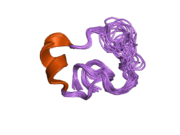| MT3 |
|---|
 |
| Available structures |
|---|
| PDB | Ortholog search: PDBe RCSB |
|---|
| List of PDB id codes |
|---|
2F5H, 2FJ4, 2FJ5 |
|
|
| Identifiers |
|---|
| Aliases | MT3, GIF, GIFB, GRIF, Znmetallothionein 3 |
|---|
| External IDs | OMIM: 139255; MGI: 97173; HomoloGene: 136800; GeneCards: MT3; OMA:MT3 - orthologs |
|---|
| Gene location (Human) |
|---|
 | | Chr. | Chromosome 16 (human)[1] |
|---|
| | Band | 16q13 | Start | 56,589,074 bp[1] |
|---|
| End | 56,591,088 bp[1] |
|---|
|
| Gene location (Mouse) |
|---|
 | | Chr. | Chromosome 8 (mouse)[2] |
|---|
| | Band | 8 C5|8 46.29 cM | Start | 94,879,235 bp[2] |
|---|
| End | 94,880,774 bp[2] |
|---|
|
| RNA expression pattern |
|---|
| Bgee | | Human | Mouse (ortholog) |
|---|
| Top expressed in | - nucleus accumbens
- putamen
- Brodmann area 9
- temporal lobe
- amygdala
- substantia nigra
- caudate nucleus
- right frontal lobe
- prefrontal cortex
- hippocampus proper
|
| | Top expressed in | - choroid plexus of fourth ventricle
- dentate gyrus of hippocampal formation granule cell
- perirhinal cortex
- entorhinal cortex
- CA3 field
- primary visual cortex
- superior frontal gyrus
- dorsomedial hypothalamic nucleus
- superior colliculus
- central gray substance of midbrain
|
| | More reference expression data |
|
|---|
| BioGPS |  | | More reference expression data |
|
|---|
|
| Gene ontology |
|---|
| Molecular function | - zinc ion binding
- protein kinase activator activity
- metal ion binding
- cysteine-type endopeptidase inhibitor activity involved in apoptotic process
- antioxidant activity
- protein binding
- copper ion binding
- cadmium ion binding
| | Cellular component | - cytoplasm
- cytosol
- rough endoplasmic reticulum
- ribosome
- astrocyte end-foot
- postsynaptic density
- synaptic vesicle
- plasma membrane
- dendritic spine
- astrocyte projection
- intracellular anatomical structure
- mitochondrial outer membrane
- axon
- inclusion body
- perinuclear region of cytoplasm
- microtubule
- extracellular space
- nucleus
| | Biological process | - negative regulation of neuron apoptotic process
- positive regulation of necrotic cell death
- cellular lipid catabolic process
- positive regulation of vascular endothelial growth factor receptor signaling pathway
- activation of protein kinase B activity
- negative regulation of cysteine-type endopeptidase activity involved in apoptotic process
- positive regulation of protein phosphorylation
- positive regulation of cell death
- response to hypoxia
- zinc ion homeostasis
- protein kinase B signaling
- histone modification
- leptin-mediated signaling pathway
- removal of superoxide radicals
- astrocyte development
- ERK1 and ERK2 cascade
- negative regulation of neurogenesis
- regulation of response to food
- protein stabilization
- zinc ion transport
- response to metal ion
- negative regulation of apoptotic process
- positive regulation of catalytic activity
- cholesterol catabolic process
- cellular response to cadmium ion
- cellular metal ion homeostasis
- cadmium ion homeostasis
- response to oxidative stress
- negative regulation of hydrogen peroxide catabolic process
- negative regulation of cysteine-type endopeptidase activity
- positive regulation of transcription, DNA-templated
- brain development
- positive regulation of gene expression
- positive regulation of lysosomal membrane permeability
- cellular zinc ion homeostasis
- negative regulation of cell growth
- positive regulation of transcription from RNA polymerase II promoter in response to oxidative stress
- negative regulation of oxidoreductase activity
- regulation of protein glycosylation
- positive regulation of ERK1 and ERK2 cascade
- positive regulation of oxygen metabolic process
- cellular response to oxidative stress
- cellular response to nitric oxide
- negative regulation of reactive oxygen species metabolic process
- energy reserve metabolic process
- cell population proliferation
- negative regulation of autophagy
- negative regulation of transcription, DNA-templated
- negative regulation of axon extension
- negative regulation of necrotic cell death
- cellular response to hypoxia
- negative regulation of neuron death
- apoptotic process
- detoxification of copper ion
- cellular response to copper ion
- cellular response to zinc ion
- negative regulation of neuron projection development
| | Sources:Amigo / QuickGO |
|
| Orthologs |
|---|
| Species | Human | Mouse |
|---|
| Entrez | | |
|---|
| Ensembl | | |
|---|
| UniProt | | |
|---|
| RefSeq (mRNA) | | |
|---|
| RefSeq (protein) | | |
|---|
| Location (UCSC) | Chr 16: 56.59 – 56.59 Mb | Chr 8: 94.88 – 94.88 Mb |
|---|
| PubMed search | [3] | [4] |
|---|
|
| Wikidata |
| View/Edit Human | View/Edit Mouse |
|

 2f5h: Solution structure of the alpha-domain of human Metallothionein-3
2f5h: Solution structure of the alpha-domain of human Metallothionein-3 2fj4: SOLUTION STRUCTURE OF a-domain of HUMAN Metallothionein-3 (MT-3)
2fj4: SOLUTION STRUCTURE OF a-domain of HUMAN Metallothionein-3 (MT-3) 2fj5: SOLUTION STRUCTURE OF sole a-domain of HUMAN Metallothionein-3 (MT-3)
2fj5: SOLUTION STRUCTURE OF sole a-domain of HUMAN Metallothionein-3 (MT-3)





















